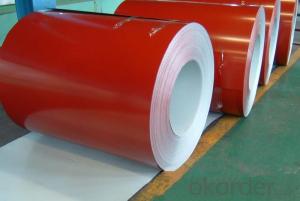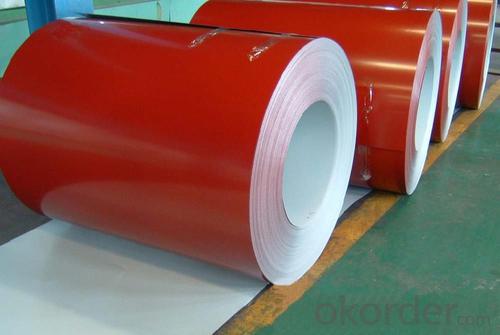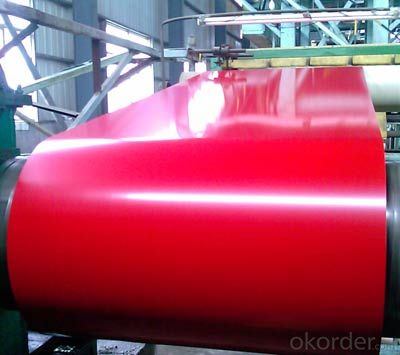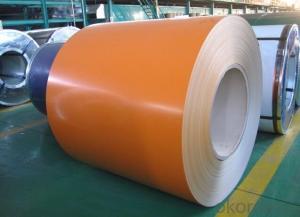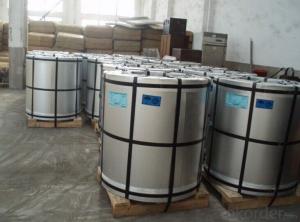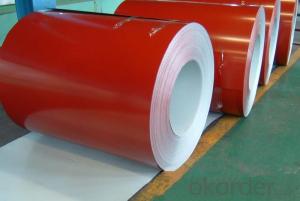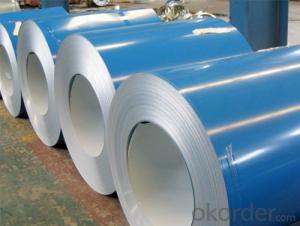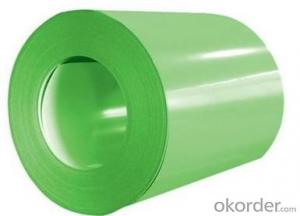Pre- painted Galvanized/Aluzinc Steel Sheet Coil with Prime Quality and Lowest Price
- Loading Port:
- Shanghai
- Payment Terms:
- TT OR LC
- Min Order Qty:
- 100 m.t.
- Supply Capability:
- 10000 m.t./month
OKorder Service Pledge
OKorder Financial Service
You Might Also Like
1.Structure of Pre-painted Galvanized/Aluzinc Steel Coil Description
the plate steel is called pre-painted galvanized (aluzinc) steel.
Pre-painted galvanized steel is good capable of decoration, molding, corrosion resistance. It generally displays workability, durability and weather resistance.
2.Main Features of the Pre-painted Galvanized/Aluzinc Steel Coil
• Excellent corrosion resistance
• Excellent weather resistance
• Capability of decoration, molding, corrosion resistance
• Workability, durability
• Excellent heat resistance performance
3.Pre-painted Galvanized/Aluzinc Steel Coil Images
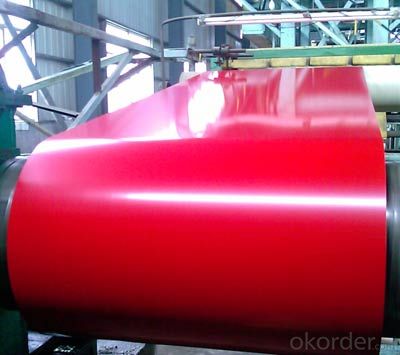
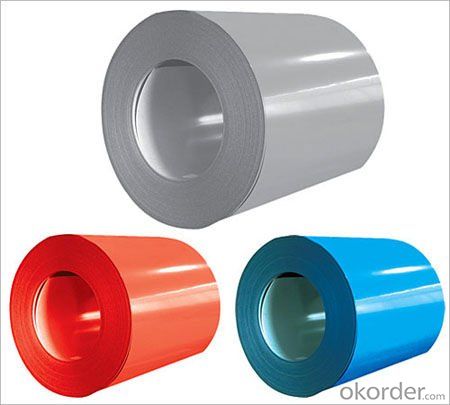
4.Pre-painted Galvanized/Aluzinc Steel Coil Specification
Finish by coil or sheet: Both sheet and coil are available
8Zinc coating: 60-275G/M2, both sides
Paint thickness for top side : 5 micron primer + (10-20) microns modified polyester, any RAL color code.
Paint thickness for back side: (5-10) microns Epoxy
Weight per coil: 4-6 tons, also can be upon customer's requirements
Max loading weight in one 20ft container : 25 tons generally
Quality standar: JIS G3312 CGCC & CGLCC
Hardness of P: Both soft and hard quality are available
Surface finish: with or without protect film
Thickness : 0.14-1.20 mm
Width : 914mm, 1000mm, 1220mm and 1250mm, thickness 600-1250mm is available
5. FAQ of Pre-painted Galvanized/Aluzinc Steel Coil
We have organized several common questions for our clients,may help you sincerely:
2. How long can we receive the product after purchase?
Usually within thirty working days after receiving buyer’s advance payment or LC.
3. How to guarantee the quality of the products?
We have established the international advanced quality management system,
- Q: What are the different types of steel coil cutting processes?
- There are several different types of steel coil cutting processes that are used in various industries. 1. Shearing: This is the most common and simplest method of steel coil cutting. It involves using a shear blade to cut the coil material into desired lengths. Shearing can be done manually or with the help of automated machinery. 2. Slitting: Slitting is a process used to cut wide coils into narrower strips. It involves passing the coil material through a set of circular knives that cut the steel into multiple smaller coils or strips of desired width. 3. Laser cutting: Laser cutting is a highly precise and efficient method of cutting steel coil. It involves using a high-powered laser to melt or vaporize the material along a predetermined path. Laser cutting is commonly used for intricate designs or when high accuracy is required. 4. Plasma cutting: Plasma cutting is another method used to cut steel coil. It involves using a plasma torch that generates a high-velocity jet of ionized gas to melt the material. Plasma cutting is known for its speed and ability to cut through thick materials. 5. Waterjet cutting: Waterjet cutting is a process that uses a high-pressure stream of water mixed with abrasive particles to cut through steel coil. This method is often used when the material being cut is sensitive to heat or when precision is required. 6. Saw cutting: Saw cutting is a traditional method of cutting steel coil. It involves using a saw blade with teeth to cut through the material. Saw cutting is effective for thicker materials and can be done manually or with the help of automated machinery. These are just a few of the different types of steel coil cutting processes that are commonly used. The choice of cutting method depends on factors such as the type and thickness of the material, desired accuracy, speed, and cost-effectiveness.
- Q: What is the process of slitting steel coils into narrower strips?
- The process of slitting steel coils into narrower strips involves unwinding the steel coil, passing it through a set of rotating circular blades called slitters, and then rewinding the resulting narrower strips onto separate spools.
- Q: How are steel coils processed for edge conditioning or slitting?
- Steel coils are processed for edge conditioning or slitting through a series of steps. First, the coils are inspected for any defects or irregularities. Then, the coils are uncoiled and leveled to ensure a flat surface. After that, the edges are trimmed or conditioned to remove any imperfections. Finally, the coils are slit into narrower strips according to the desired width.
- Q: What are the pros and cons to selecting a graphite shaft sand wedge over steel shaft?
- The way to resolve the selection is to go with the shaft that matches the other clubs in your set. If you have steel shafted irons go with steel. You will find the similar feel when you hit shots is most important.
- Q: Iron melts faster when there will be low carbon in Iron.During steel making the molten Iron gets purified and alloying being done through the process. How the carbon is being controlled at Iron melting stage and what it is called?
- Steel is usually made in a two-step process. As you may know, carbon, in the form of coke, is added to the iron ore during the initial smelting process. This is the first step. The conversion of iron ore into raw iron is accomplished with a blast furnace. Carbon dissolves with the iron during the smelting process. The amount of carbon in the iron is generally not controlled at this point as this would be too difficult, the excess carbon is removed in the next step. The result is pig iron which is crude iron that has a very high carbon content, and a large amount of impurities. Pig iron is almost as brittle as glass, and it is useless in this form. In most modern steelmaking operations, molten pig iron is tapped from the blast furnace three or four times per day- it is not allowed to cool. The liquid pig iron is carried in ladles directly to a Basic Oxygen Furnace which converts the pig iron into steel. The basic oxygen converter uses a stream of pure oxygen to burn off the excess carbon. Impurities are also burned off, particularly phosphorus, silicon, and sulfur (which damage the steel's properties.) These elements all have a much higher affinity for oxygen than iron does, so the iron itself remains unchanged. Once the carbon content and the impurities are reduced to the desired level. The oxygen is shut off, and the iron has now become steel. At this point other alloying elements may be added, such as chromium, manganese, or molybdenum. These elements improve the steel's properties, but also add to it's price. If necessary, more carbon can be added as well if the carbon content has accidentally dropped too low. Finally, molten steel from the basic oxygen furnace is poured off. It can be cast into ingots, billets, or thin slabs.
- Q: How are steel coils used in the production of steel containers?
- Steel containers rely heavily on steel coils as a vital component in their production. These coils, made from flat-rolled steel, serve as the foundation for the container's main body. To start the process, the steel coils are unwound and fed into a rolling mill. Here, they undergo a sequence of procedures to shape and mold the steel. One of these steps involves heating the coils to a specific temperature, making them more malleable and easier to manipulate. Subsequently, the hot coils pass through a series of rollers that gradually reduce their thickness and elongate them to the desired size. This entire procedure is referred to as hot rolling. Once the steel coils have been rolled to the necessary thickness, they are then cooled and transformed into sheets. These sheets are further treated to eliminate any imperfections or irregularities, guaranteeing a smooth and even surface. This is accomplished through processes like pickling, where acid is used to remove any scale or rust, and cold rolling, where the sheets are passed through rollers at room temperature to achieve the desired thickness and surface finish. After the sheets have been cleaned and refined, they are molded into the shape of the container. This typically involves a technique known as stamping, in which hydraulic presses are used to press the steel sheets into a mold. The mold determines the container's shape and size, and the steel sheets are pressed against it with great force, resulting in the desired container shape. Once the containers have been formed, they undergo several finishing processes, including welding, painting, and coating. These processes are carried out to enhance the containers' durability, appearance, and resistance to corrosion. These final touches ensure that the steel containers meet the necessary standards and are of high quality for their intended use. In conclusion, steel coils are of paramount importance in the manufacturing of steel containers, as they provide the raw material needed for their production. Through a series of steps, the steel coils are shaped, cut, and formed into sheets, which are then further processed and molded into the desired container shape. The outcome is a robust and dependable steel container suitable for various applications across industries.
- Q: If i get a samurai sword made of carbon steel, what is the hardest thing i can hit before it breaks? Or will it not break?
- Real katanas need regular maintenance, they rust easily and dull quickly. If you get a replica chances are it will break the first time you hit anything with it. If you can find one, the WW2 officers swords were of good quality and the modern metals mean it doesn't rust or dull as easily. If you do insist on getting a carbon steal blade be ready to oil it often. It will rust at the mention of moisture.
- Q: How do steel coils contribute to earthquake resistance in structures?
- Steel coils contribute to earthquake resistance in structures by providing strength and flexibility. When used as reinforcement in concrete structures, steel coils help to distribute and dissipate the energy generated during an earthquake. This helps to prevent the excessive deformation or collapse of the structure, enhancing its overall seismic performance. Steel coils also improve the ductility of the structure, allowing it to withstand the dynamic forces and vibrations caused by seismic activity.
- Q: What is the role of steel coils in the automotive industry?
- Steel coils play a crucial role in the automotive industry as they are the primary raw material used for manufacturing various components and parts of vehicles. These coils are typically made from high-quality steel and are formed into a continuous strip, which can be easily processed and shaped into desired automobile parts. One of the key applications of steel coils in the automotive industry is in the production of body panels and frames. These coils are processed through stamping and forming techniques to create panels such as doors, hoods, fenders, and roofs. Steel coils provide the necessary strength, durability, and rigidity required to withstand external forces and protect the passengers and other components of the vehicle. Moreover, steel coils are also utilized in the manufacturing of various structural components of automobiles. Chassis, suspension systems, and other critical parts such as engine cradles and brackets are typically produced using steel coils due to their excellent mechanical properties. Steel coils possess high tensile strength, which enhances the overall structural integrity of the vehicle and ensures safety. Additionally, steel coils are integral in the production of automotive springs, which play a vital role in the suspension system. Coil springs, leaf springs, and torsion bars are commonly utilized in vehicles to absorb shocks, provide stability, and maintain proper ride height. The use of steel coils in these applications ensures optimal performance, durability, and longevity of the suspension system. In summary, steel coils are essential in the automotive industry for their versatility, strength, and durability. They are used in the manufacturing of body panels, frames, structural components, and suspension systems. The utilization of steel coils in these applications contributes to the overall safety, reliability, and performance of vehicles.
- Q: density of mild steel (MS) is 7850 KG per metre cube , but i want to know the density of stainless steel
- Stainless steels are the most dense, coming in at 8000 kg/m3. Though the densities vary, The answer is 8000 kg/m3. 301 stainless density values seem to vary according to the supplier data sheets, from 7.88 g/cc, (AK Steel) to 8.03 g/cc, (Allegheny Ludlum)
Send your message to us
Pre- painted Galvanized/Aluzinc Steel Sheet Coil with Prime Quality and Lowest Price
- Loading Port:
- Shanghai
- Payment Terms:
- TT OR LC
- Min Order Qty:
- 100 m.t.
- Supply Capability:
- 10000 m.t./month
OKorder Service Pledge
OKorder Financial Service
Similar products
Hot products
Hot Searches
Related keywords
